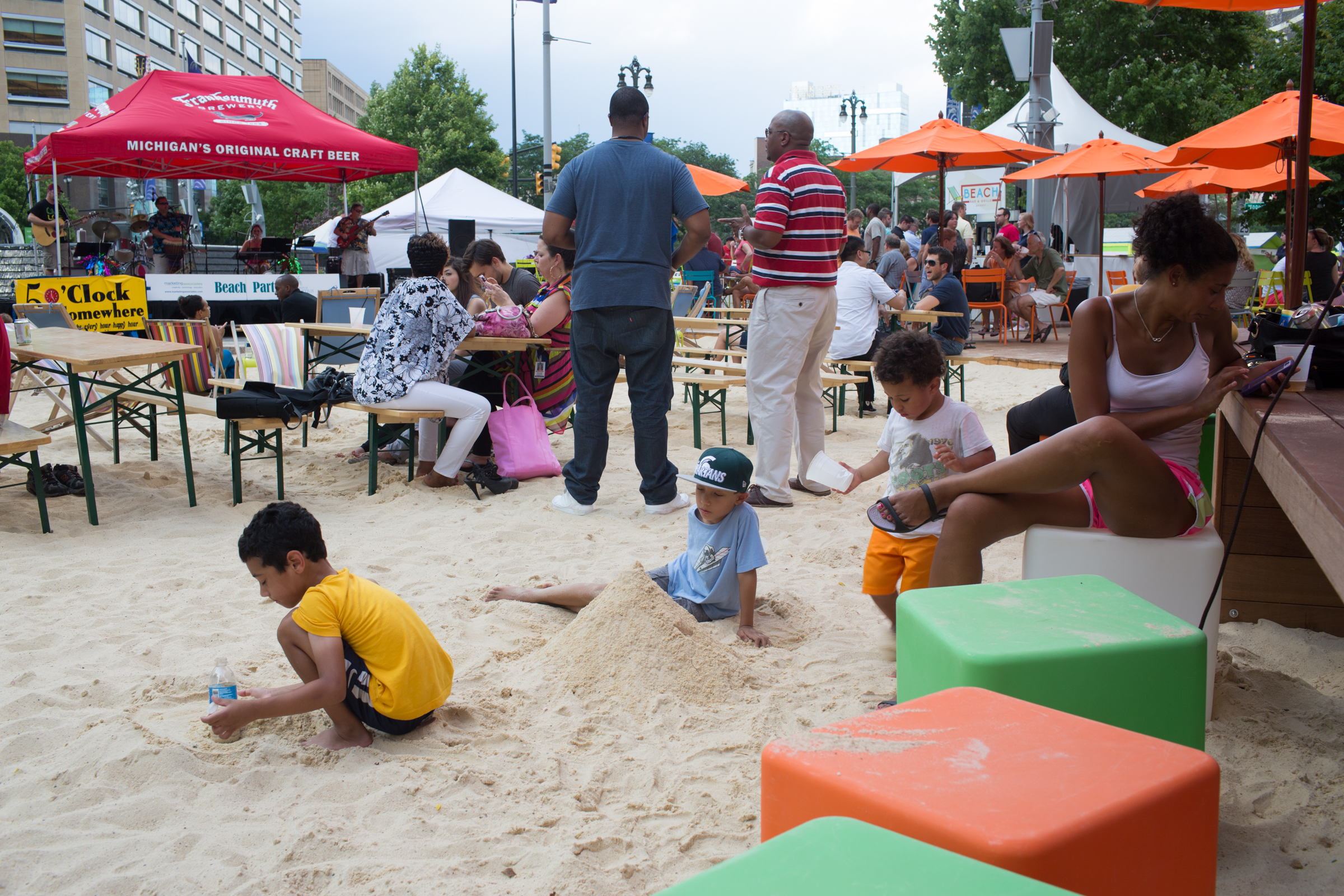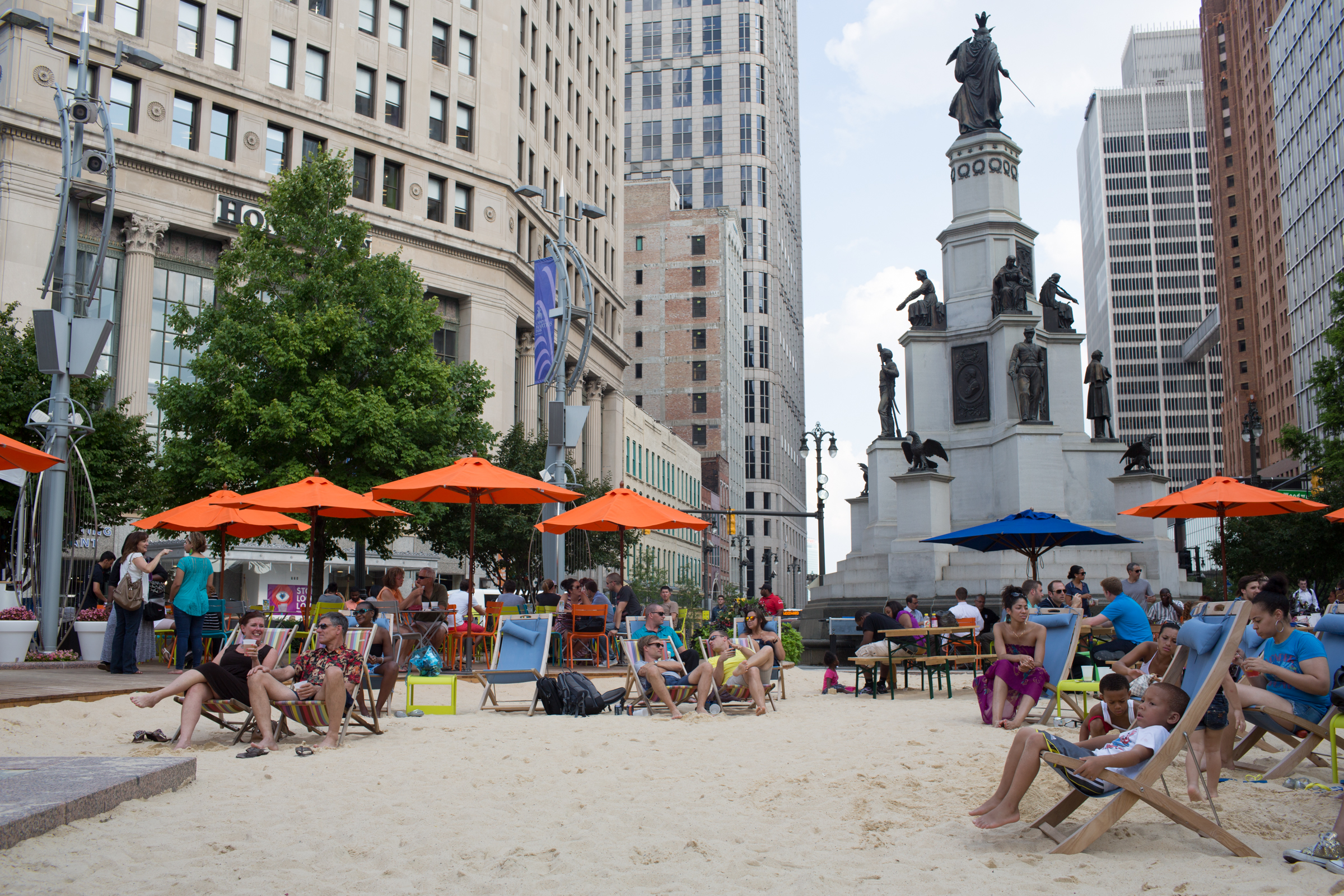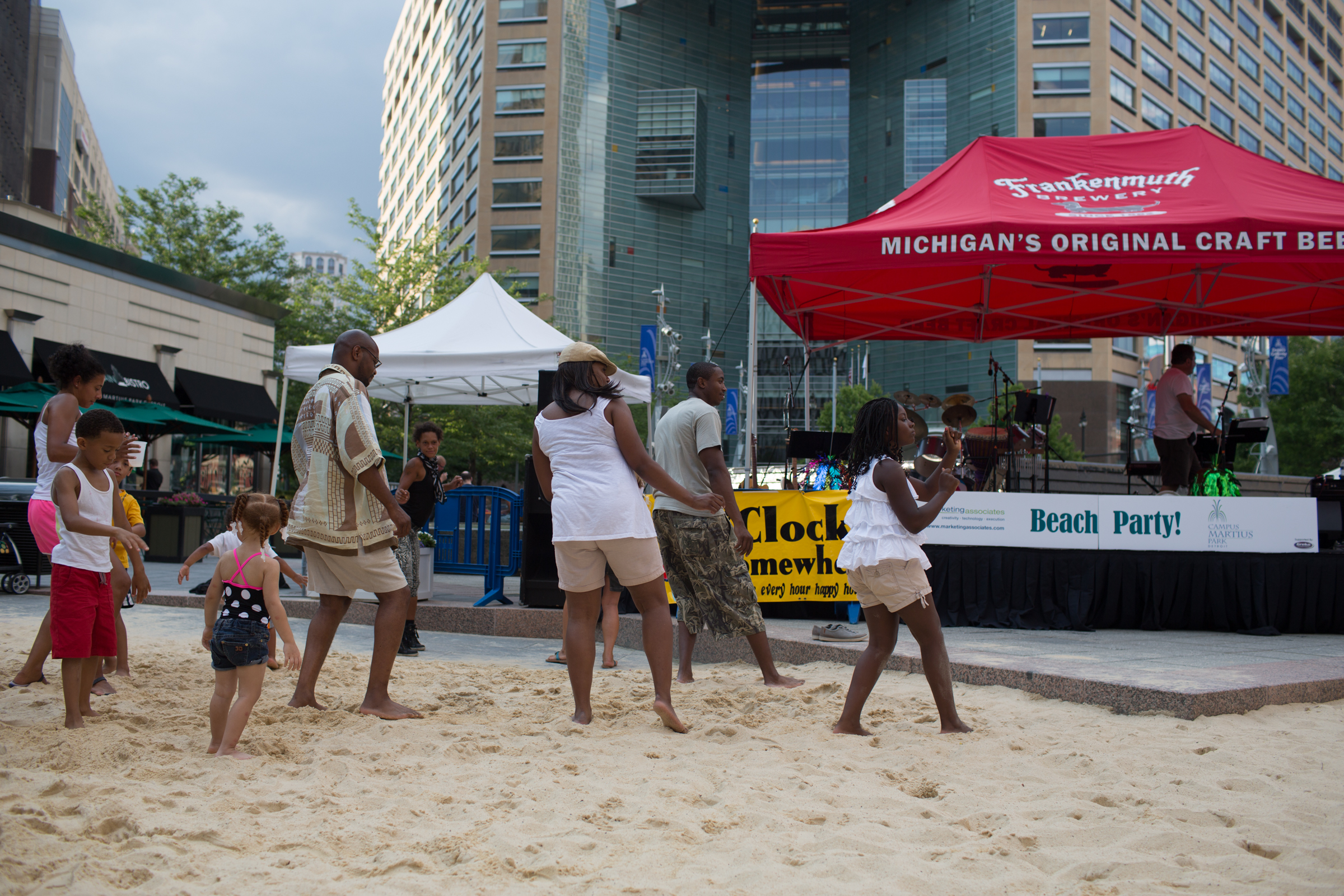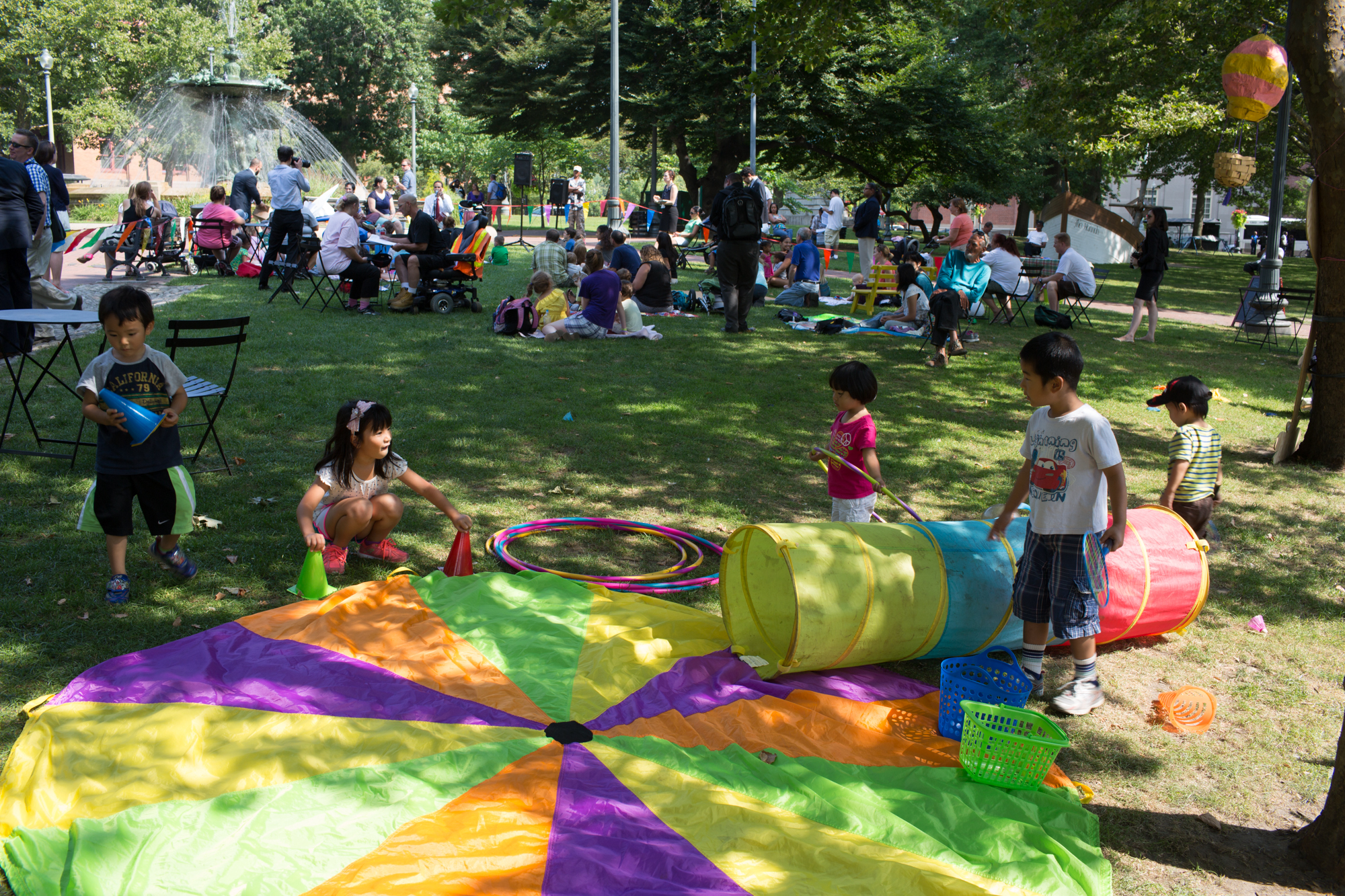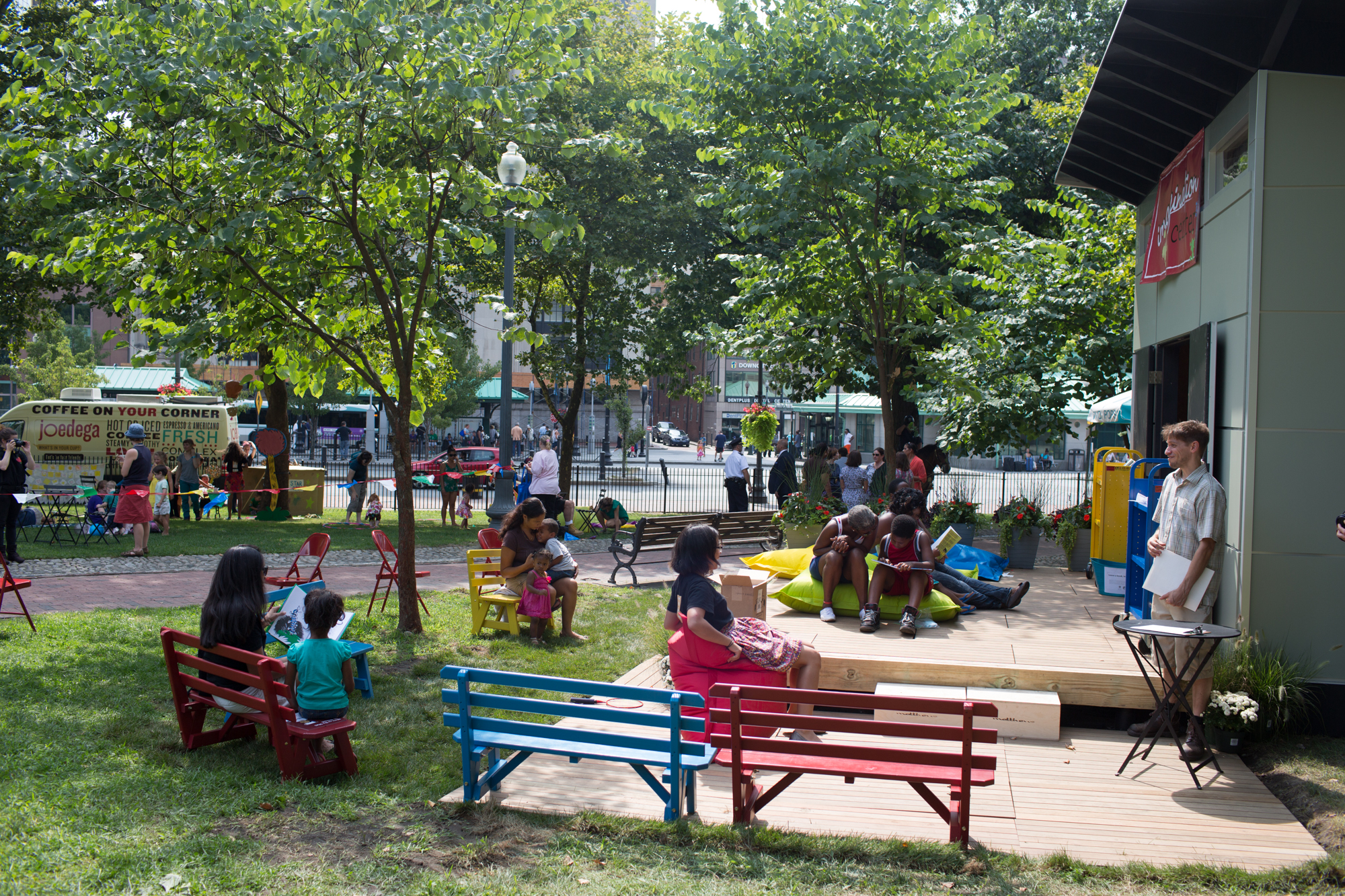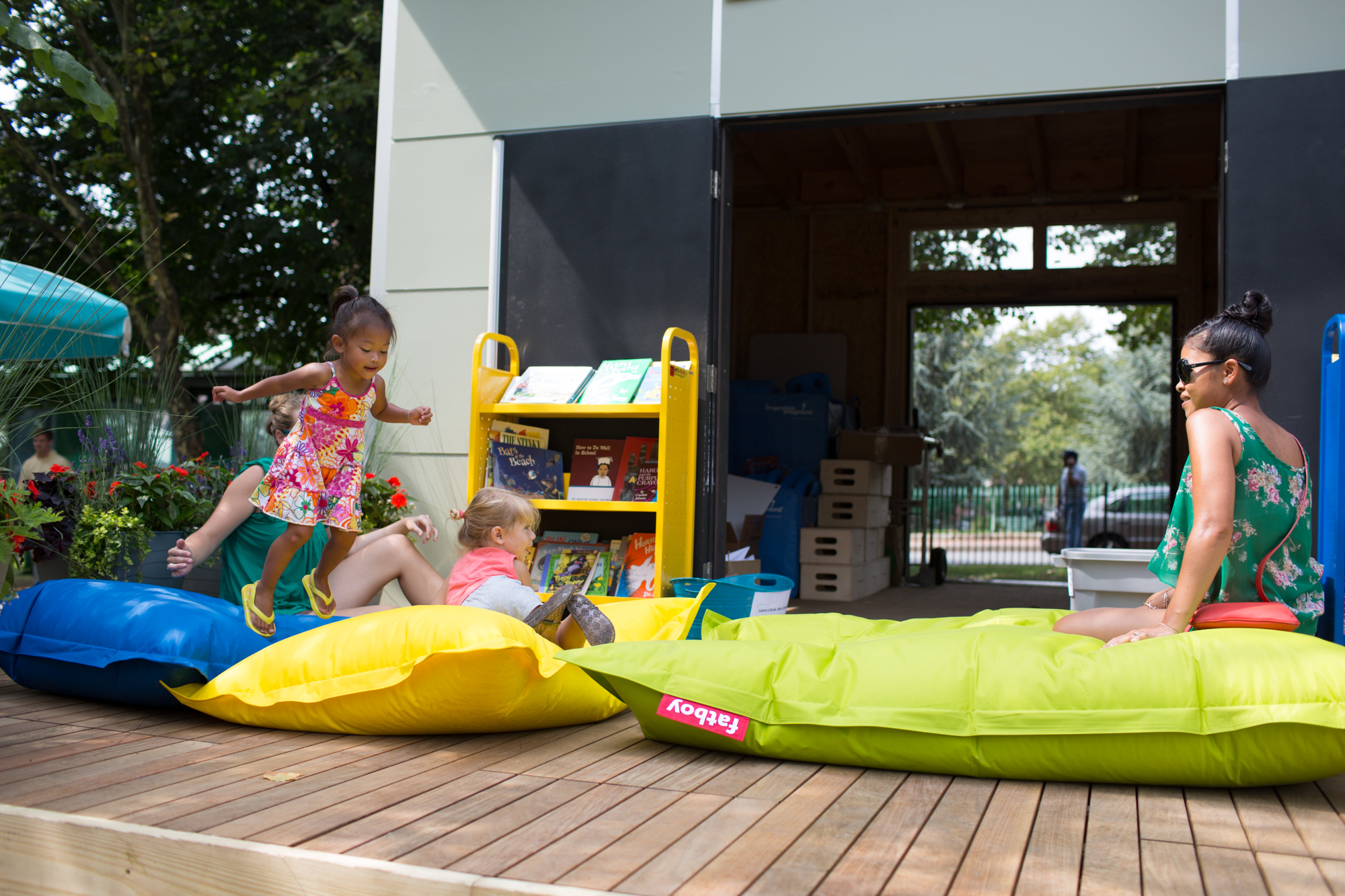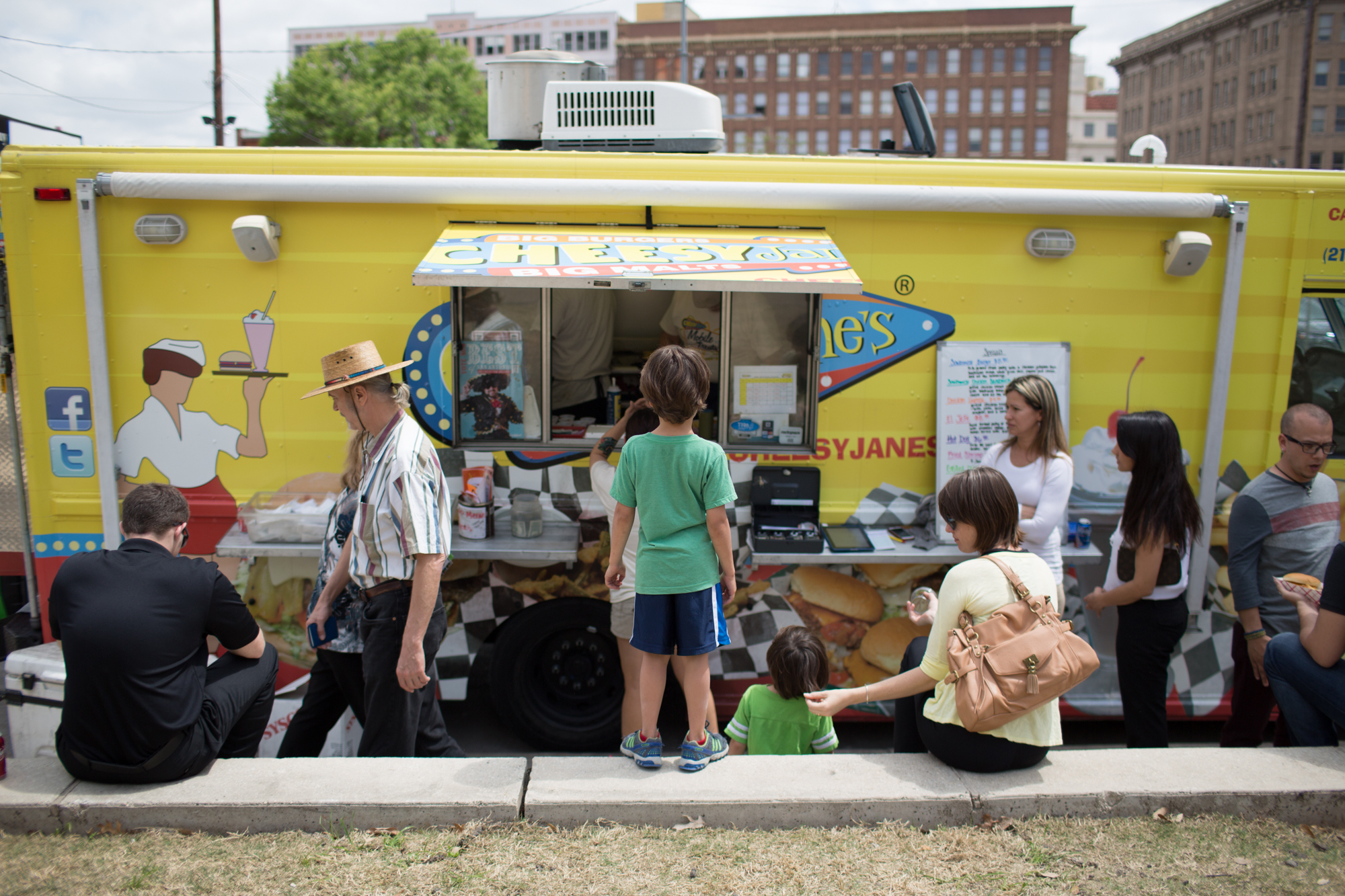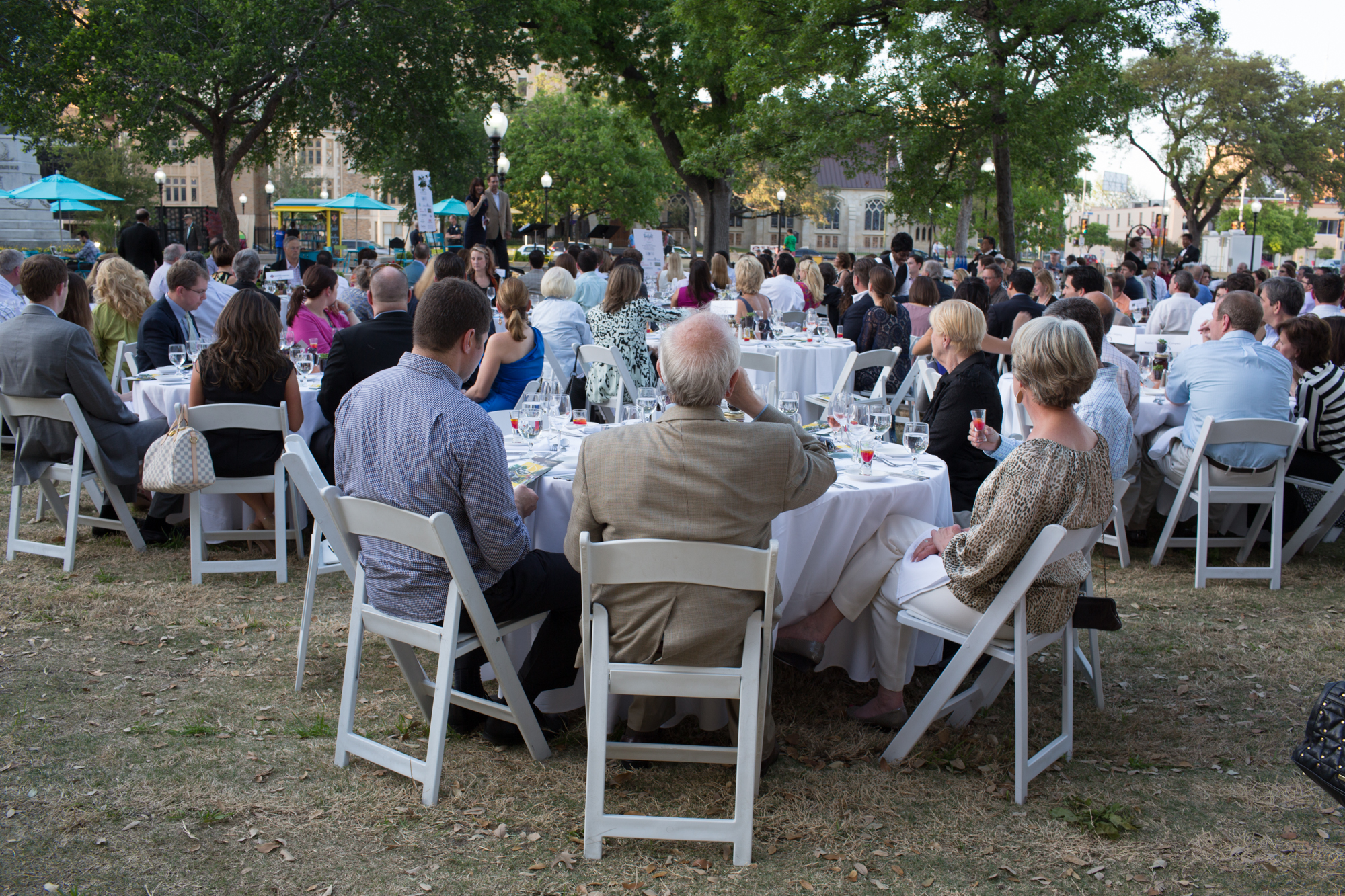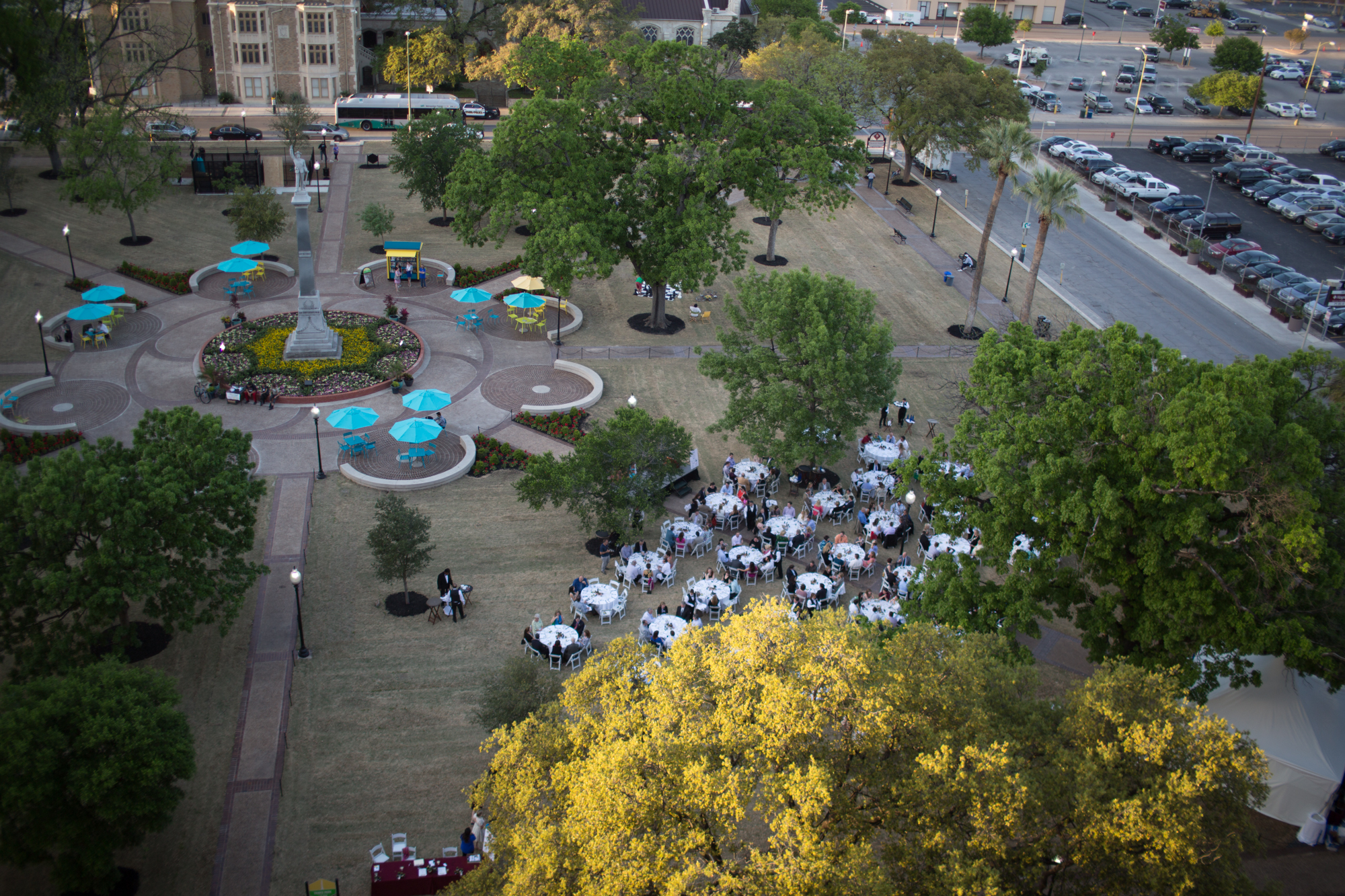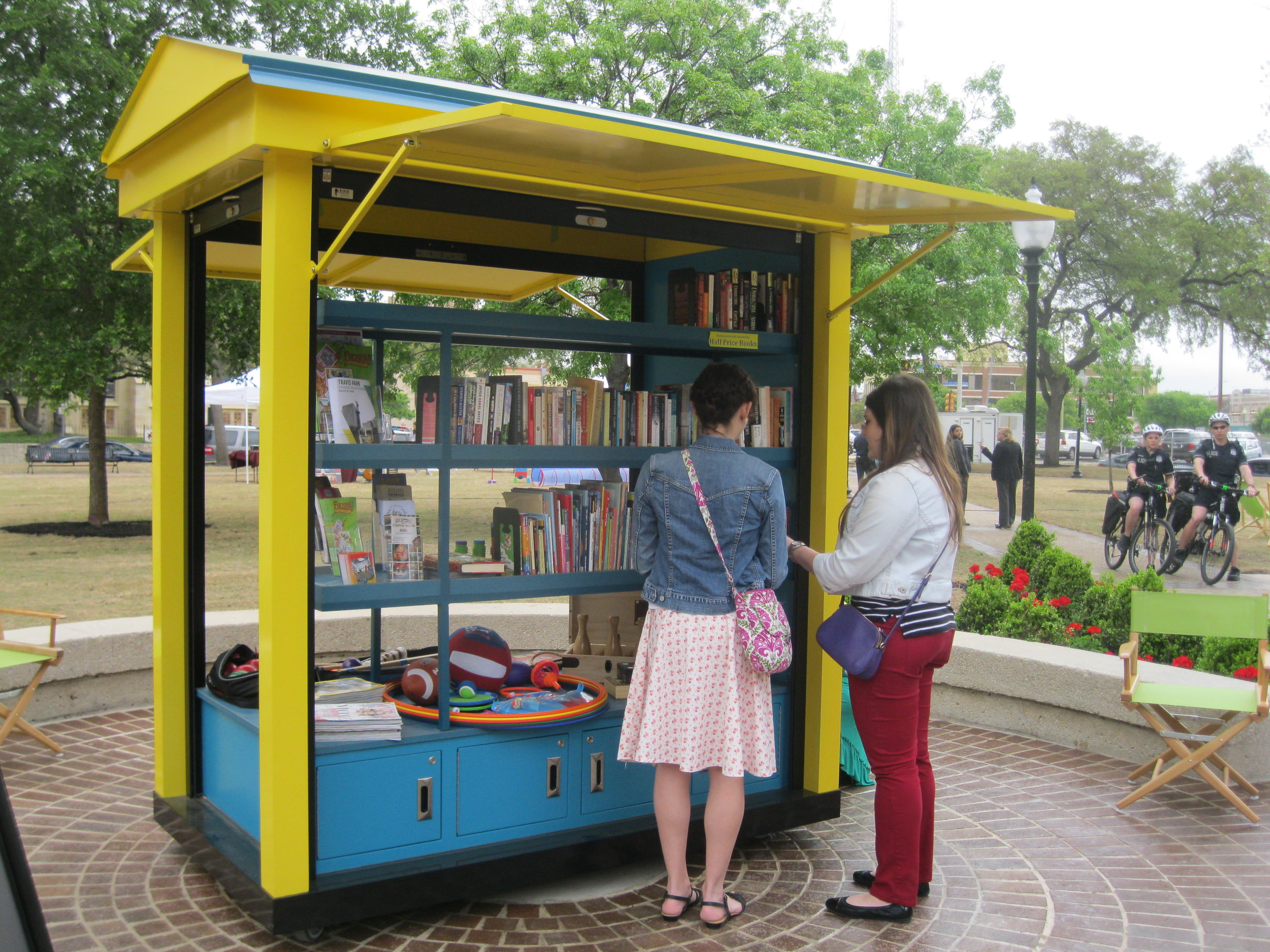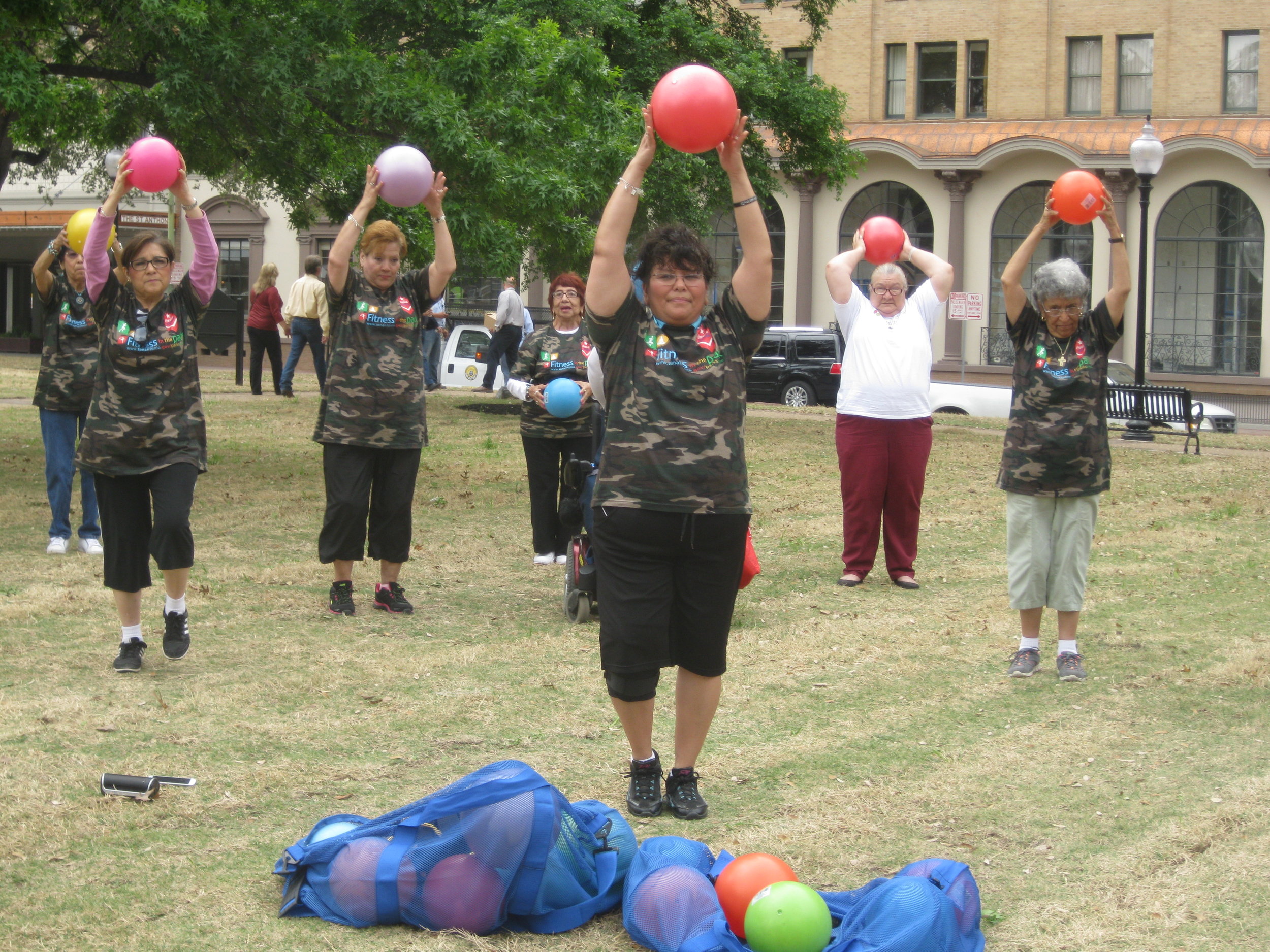Elena Madison in Prague, PPS, New York in Prague during the conference: Community, Come On! Foto (c) Nadace Via
Elena Madison is the Vice President at New York Based organization called Project for Public Spaces (PPS) and a leading specialist in placemaking. She is an urban planner with rich experience in the planning and design of parks, plazas, campuses, civic and cultural institutions. Elena is an expert in collaborative visioning, concept development as well as management and programming for public spaces. Elena was born in Sofia, Bulgaria and settled in New York City after obtaining her Master's Degree in Urban Planning from City University of New York’s Hunter College. She keeps abreast of the Central and Eastern European context through lecturing and collaborations with placemaking partners in the region.
Interview by: Dominika Belanská
May 2016, Prague
On Placemaking
Planning, as it is practiced in our cities, does usually not employ temporary interventions or interim use, for testing solutions before a bigger transformation investment is made... How does placemaking fit into the picture of city planning?
Placemaking is not contrary to long-term planning. It's a component of long-term planning and it should inform long-term planning decisions. It is, in essence, a participatory framework focused on public spaces that can produce significant, long-term plans. It can be used to develop green space or public space plans, or these same components of general or master plans. Better yet, it recent years we have been asked by municipalities to develop placemaking plans, which outline a strategy not only for public space, but for placemaking that can be applied locally to many different sites.
The short-term aspects of placemaking are often focused on experimenting, testing programs or elements - or even a place - to see if people actually come and if they do what you expect them to do... Other times it’s more about seeing that a place is valuable – when a place that wasn’t seen as a place of value starts to work and becomes significant because you have done‘placemaking on it‘ – and then the municipal authorities and other people begin to turn their attention to it. But it also happens that the lighter, temporary interventions go away, and the long-term, very expensive changes that take their place are rather questionable - both from a design and functionality point of view, and you end up with spaces that you have to adapt to use, even though you’ve spent all this money on them.
What can be done to prevent this and make the transition from the temporary to the long-term design and use more consistent?
Ideally, the local ‘guardian‘ of the placemaking process, is the one who has to assure that the long-term design remains true to the placemaking vision. That local “guardian” could be a community partner, a municipal representative, or even a consultant or a designer, someone who is vested in the placemaking vision and has been a part of it from the get-go. Someone who understands it and embraces it, and continues to be engaged in the entire process of the design and construction, which in some places can take years. That local guardian may also be involved in programming and the life of the space. That is the other challenging part – once you built it, it doesn’t mean it’s going to work on its own. The place needs care and attention constantly. Sometimes it all depends on the management. As one of the ‘Eleven principles of placemaking‘ by PPS goes, “You are never finished“.*
*The 11 placemaking principles by PPS can be found at www.pps.org/reference/11steps/
The term ‚placemaking‘ doesn‘t really have an equivalent in Slovak or Czech language...
It doesn’t translate well into other languages. But what I like about the term and the practice, is that it is about the making, about the action, not just about planning or design. When you do it ‘on the ground‘ you are engaged into the practical details. Placemaking breaks the barriers between the designers – or the thinkers - the makers and the doers. Especially in the field of parks, there is such a big gap between the landscape architect and the people who are actually on the ground mowing the lawn or planting the flowers. It is nice to see them come together to work on the project collaboratively. Professionals typically do this kind of collaborative work early in their careers or when they are in school, but once they get the “real job” they become more and more siloed. Placemaking is all about collaboration and working across the disciplines, together. We are there to support each other’s work.
How do you explain what is the value and impact of placemaking to the local authorities, that you work with?
We are trying to show both qualitatively, and by the fact that the people are enjoying the places that it makes sense to do it. We also try to show impacts with numbers, to be able to say to the mayor or the economic development department, ‘'Look, you invest this amount of money into this public space and this is all the stuff that you can get in return’'.
I also like to ask them the question ''What would be the real cost of not doing anything?” What is the real cost of abandoned parks, empty plazas, and vacant lots? I think local authorities are beginning to see that picture clearly today.
The field of public space improvement is also starting to establish some shared metrics - we are starting to measure more or less the same indicators, like economic impacts. But the benefits of the work we do is not only economic. There are also cultural, health, and important social inclusion benefits of placemaking. When you do it right, your place becomes inviting and welcoming and helps include a whole variety of people, not just the people who happen to be there.
What would you describe then as a successful project, in matters of diversity and social inclusion? What are the indicators?
The beach project in downtown Detroit’s Campus Martius park is a great success story. Five years ago, after 5 o’clock there wouldn’t be anyone on the streets downtown because the park, Campus Martius, is surrounded by office buildings and the office workers go home, or rather drive home, after 5. There wasn’t really much to do downtown, unless there was a special program in the park. If you go there now at 8 p.m. or even 10 p.m. there are actually people on the street. To me that is a huge indicator of success, a visible change that no one can deny. In the beginning there was criticism that this beach environment is only for white downtown office workers and only they will feel welcome at the beach. But you don’t hear this anymore because anyone who has been to the space has seen the huge diversity of people who use it. You don’t have to consume anything to be in the space, so it’s not about who can afford to pay. There’s is actually a whole cadre of people who are in the park everyday, who are clearly not downtown workers. There are also now kids, and their parents, playing in the sand. They were not there before. There is a good mix and people of color, so who you see in the park actually reflects, to a certain degree, the overall makeup of the City of Detroit. You can look at the photos and you’ll see that the space is very diverse and inclusive.
Does this show up in numbers?
The revenue from the space is within the realm of half a million dollars a year. The little outdoor beach bar runs from May to October makes that much money every year. They’re employing a number of people so there is also new employment. All these numbers have been recorded now and are being tracked. But the biggest success is that you have a great diversity of people using the park and being comfortable there, as opposed to feeling unwelcome, or being there just for a special event or for a particular performer. Speaking of indicators of success, in 1990 there were about 60 000 people who worked in downtown Detroit and this year the last count was 100 000 people, so it’s a 40% increase in 15 years. That’s a very clear indication that the efforts around public spaces downtown are a success and downtown is attractive to companies to come back and bring workers back. Just in the last couple of years a dozen new food, beverage, and coffee shops have opened just within a block‘s radius of the park. It’s because the people are coming, they are voting for this place with their feet.
Placemaking on 78th Street, New York City. Foto (c) Project for Public Spaces
To bring new people and new businesses is very positive for a shrinking city like Detroit that has been facing a major crisis. On the other hand, there are cities where we can recognize the downsides of gentrification. How to keep a balance in what is still beneficial for the local communities and what could eventually push them out, like in places with a lot of tourism?
We don’t have the silver bullet for it, but the recipe always has to be that the people who are there right now have to be included. They have to be a part of the process and claim that space as their own. From a public space perspective - because we’re not dealing with spaces that are necessarily for rent and we’re trying to create the public realm that’s inviting to everybody - successful placemaking helps the locals, the long-term residents, those who may be at risk of displacement to claim the place as their own, to be present in the public space, to know that the place is for them and that they have a real say and a stake in the place. When the process works, the space ends up supporting and showcasing the local, the authentic, the community’s culture and activities and not supporting gentrification. The problem comes when cities and designers focus on programs and amenities to attract only certain kind of people, like ‘We want young creatives, we want millennials’. Well, and what about everybody else?
Ideally, diverse programming and amenities of the place should attract diverse people, so they grow a sense of ownership through its use. But to really include everybody in the planning and making of a place can be a complicated challenge...
Of course, it’s easier to talk to the ‘young creatives‘ - because they come to meetings, they use social media, they fill out the surveys online - than it is to talk to seniors who may or may not come to meetings and may or may not want any change. It’s really a difficult task for the placemakers to actually engage with the existing community in a meaningful way. We need to have this fair effort to include the people who are already there - and also understand for example why they are not using the space. The reason can be very obvious if there are no amenities there, but other times there are histories and politics and interpersonal matters that are involved that can make a space a no-man’s land for some residents. The process itself can serve to resolve some of these issues or at least get closure on them. We have seen it work well even in conflict situations, such as in Israel, in East Jerusalem, where one of our project associates worked with both a Palestinian community and a Jewish community and was looking for tools to bring people together. Or in Kosovo, where we are supporting local partners in using placemaking to bring divided communities together around a concrete place. Placemaking can bring people together in a pragmatic way that focuses everyone’s attention on concrete problems and practical solutions and that helps work around political, ethnic or cultural conflicts.
How could placemaking help in conflict situations particularly?
Because it’s so concrete and you are talking about a very specific thing - a very specific place, it’s a good way of starting dialogue and getting groups that may be in conflict on other issues to cooperate and at least to hear each other out. Some of the lessons from conflict zones apply to places that are under a lot of pressure from gentrification, because in essence gentrification is conflictual.
Do you employ any measures in your projects, so that they wouldn’t stimulate the gentrification processes?
The best we’ve been doing so far is making sure that the existing communities are actually very involved and they’re claiming the place for their own. The placemaking process offers opportunities to expand the discussion to go beyond the public space and to talk about local businesses, housing, schools, other needs. For example, in gentrifying parts of Brooklyn long-term residents are not necessarily displaced right away, but it becomes less and less comfortable for them to live there because the cheap store where they were buying their food or coffee is now replaced by something else. As placemakers we don’t have control over new businesses opening and old places keeping in business. But we can encourage existing local businesses to offer goods or services in the public space, and hire local people for the jobs available in the public space. I don’t believe that the way to combat gentrification is by not improving places, by not improving people’s lives. I don’t think we want to live in places that are uninviting and empty just so we can keep our rents low. We should all be trying to make our lives and those of the people around us better, not worse. We should not keep our shared public realm in poor condition just so that other people don’t enjoy them. This is not a winning strategy. The strategy that has worked is supporting local businesses and residents, engaging them in what is going on in the public space so they can benefit from more people, more social connections, a richer life, and maybe even more money, so they don’t have to move.
The Mayor of Providence is reading for kids during public happening on Kennedy Plaza. Foto (c) Project for Public Spaces
Local authorities have a number of important competences and tools, for example they set opening hours that have huge impact on the local businesses and considerably affect the life in public spaces. In your practice, have you seen regulations or legislation being revised to support the goals of the placemaking process, or to respond to its outcomes?
Sometimes the municipal regulations need to be reviewed and revised so they make sense in the ‘new world‘ where public spaces are a living, shared public good. Often there is a desire to host celebrations and special events as a part of public space activation. These are not necessarily permanent activities but are a way of raising the profile of the public space, making it more attractive to visit, but also of raising revenue for the maintenance and the programming. And often these kinds of events are very difficult to obtain permits for, because we may deal with laws and regulations limiting commercial activity in public spaces, or specifically the sale of food and alcohol, and sometimes the sale of anything at all. There are stringent laws regarding alcohol consumption (ABC laws), which were adopted widely throughout the US and restrict not only the sale of drinks but drinking in public. Especially in the South these laws require public space events, where alcohol would be served, to have police security present and fences limiting the access to the space where one can have a drink. Every city has a different version of these municipal ordinances. Regulations of staged events, amplified sounds, and so on, are also part of the reality of programming a public space. In many cases we’ve had to work with our local partners and the municipality to either revise these laws, if there is enough support in the city council to do it, or to grant some kind of exception or compromise to make an event possible. For example, we’ve had to negotiate a special exception to make a beer garden possible in public park without 6 foot high walls, using instead a little roped fence... But in many places, there’s a real change taking place in legislation to allow all types of public space uses because municipalities see it as positive and productive, and because people want to see more and more dynamic activities.
What is the reason for this change of perspective?
It’s connected, at least in the US, to a big demand to demonstrate that the public spaces are eventually going to be economically self-sustaining. I understand that need, but I also think it’s very skewed. When a public school is built, nobody is expecting that it is going to be paying for itself. It is accepted that it’s a public good and we all pay taxes to make sure that children are taken care of. With public space that is often not the case. Especially in places where hasn’t been a history of particular investment - and it doesn’t matter if it’s in the United States or Central Europe - we usually hear from the municipality ‘Well, we come to plant flowers twice a year and we pick up the trash every other day, but can you recommend a bench that doesn’t need any maintenance?’ All the additional investments that are needed to have active uses in a public space - a regular program, physical amenities, etc. - are seen as an extra, as if it was not necessary for the municipality to pay for those. Good public spaces, and the ability to enjoy and engage in your public space close to home, are not an extra service, they are not a luxury only some deserve, they are a basic human right. This should be something that the municipal funds are allocated for, just like they’re allocated to pay for roads or parking.
But because of that expectation, that a public space is somehow going to make money to sustain itself, people have been amazingly creative with ways to cover at least some of the costs. People have donated time, labor, knowledge, design, and have worked to physically build playgrounds or benches to improve their public realm. There are many community partners who are willing to make an effort to make the spaces work, if we will look. Whether it‘s throwing a fundraiser party for the park or organizing free classes, it’s showing a different thinking and the support the space has. The key is that we don’t want to privatize the public space, we want to keep it public and that means that we need to have public support which has to translate into financial support as well.
Some of the potential users cannot afford to pay to sit in a café, so if a public space or part of it is financed by a revenue or rented out, they might be left out or feel unwelcome. Do you see ways of keeping the balance and diversity of users while sustaining the costs of management?
In the US, one of the mechanisms used to keep that balance is public-private partnerships. Six or seven years ago in Central Europe people were very apprehensive of this idea, they thought public-private partnerships mean concessions – the parks department puts a tender out and a concessionaire is selected to take over and run an amenity, e.g. a restaurant, in the park. And ‘of course‘ the building that is leased and the land around it becomes a private space... and slowly people see the park becomes a restaurant space, which is great for those who can afford it, but for the general public it’s not such a good solution. But in recent years I’ve seen this very simple understanding of public-private partnership evolve. Now I see the municipalities are becoming a lot more sophisticated and understand that this partnership does not necessarily mean private leases or private entities renting, owning or somehow controlling public spaces. It is becoming more common to solicit private contributions for specific areas or physical elements. I even have seen private foundation support, or the forming of friend groups that support the place in various other ways without necessarily “giving it away”, which is always the big concern. But there’s also regulatory and other ways to make sure that balance exists. Great parks around the world are full of cafes and restaurants without becoming private places so it’s possible to manage it. I have no interest for public parks becoming private, but we need to make public parks work at the level that today’s quality of life requires. Because an empty park with nothing to do in it is no better than a private park.
The issue of privatization of public space involves parking policies as well. In Slovakia, the law actually allows cars to be parked on the sidewalk, as long as you let 1.5 m for the pedestrians to pass around. Following this logic and growing demand, parking lots are also officially drawn on existing sidewalks...
That’s completely not acceptable. No one is doing this now. I don’t believe parking is a given and it shouldn’t be a free good for the public. It’s one thing when you live in a community where the only way to get around is by a private vehicle, but when there are other transportation options, parking should be something you pay for. The question to everybody should be, ‘Honestly, what is the best, highest use of this sidewalk space’? Is it better for you to be able to park your car there or is it better to allow people to be safe and comfortable on the streets? And what is going to improve the quality of life for the residents in your city? Is it cars, or is it people? When you plan for cars you get more traffic, when you plan for people, you get more people. And that’s what we all should be doing - we should be planning for people.
Paradoxically, it is the people themselves who usually complain about reducing parking or pedestrianization...
The same goes for a lot of shopping areas in the US, the people complaining are usually merchants who are afraid that their customers are not going to be able to drive to their store and they are going lose business. Research on this topic shows that more foot traffic (people on foot, walking by your store) means more potential customers. Cars don’t shop, It’s the people that shop, so as long as you give them a reasonable place to park and an exciting environment to walk through, they’re willing to walk some distance, they don’t have to park right in front of your store. There are exceptions of course, like the elderly or the disabled, but in general, people should be able to walk. But with cars parked on the sidewalk, that walk becomes unpleasant and hostile.
We see it a lot in residential areas too, where residents want to park right in front of their building, as if they never get out of the car and fly into their home without setting foot on the sidewalk. It’s a big problem and we just have to be smart about it and banish cars from sidewalks.
There’s been a positive change in that direction all over Europe and in the US. I can’t even think of a European capital that still encourages parking on the sidewalks. Look at how Prague has changed. It wasn’t that long ago when they were also parking on the sidewalks.
On public sector and collaboration
Does it really work, bringing all involved departments and politicians together?
Because we’re trying to rethink how we work as professionals in very specific disciplines around public space, shared space or shared resources, there’s no reason why we shouldn’t rethink how municipalities are structured around these issues. It is very useful for municipal employees to have a regular counterpart from a different department that they can approach for specific issues. I’ve found that work very effective. But I’ve also seen it fail, mostly because people assigned to the committee were actually too junior. So they could have been very engaged and really good, but the senior leadership was actually not listening to them, and the reason they send them to this committee was because they thought it was not important. In other cases, the decision makers are just not on board. But the earlier they are involved, the better. They need to understand where the conversation is coming from, so when you ask them to change the municipal code, or to authorize a special permit, or to provide a particular service, they’re actually prepared for it.
The only way citizens are going to stay involved and keep improving their city is if their work is recognized.
In the meantime, we see a lot of citizens becoming impatient while ‘plans are being planned‘, and they invest their own effort to revive and sustain places - they even fix sidewalks and clean the city themselves. It seems like the roles are shifting, but in reality, the competences do not. What do you think would be a constructive approach to the energy of the citizens and their willingness to be part of the making?
Hands-on is always good. As Margaret Mead puts it, ‘Never doubt that a small group of thoughtful, committed citizens can change the world. Indeed, it is the only thing that ever has‘. So yes, people should go and do things in their public spaces. And if they have to start doing it without permission? Fine... as long as it makes sense, of course. Especially at the neighborhood level, there is room for things that are very DIY and look “hand-made”. There are of course other situations where the city wants the amenities and the public space to look a certain way, depending on what image it wants to present to the world. Still, there's always room for people to be involved with hands-on activities and program if that’s what they're interested in. And the only way citizens are going to stay involved and keep improving their city is if their work is recognized. Notice I didn’t use the word rewarded. People are not taking action in their public space because they expect to be paid for it, but they want to see that their effort can eventually evolve into something either bigger, something better, or something more stable.
From your experience, how can we make the municipality and the citizens come together to discuss what this ‘bigger and better‘ should be? How can we encourage them to collaborate on a shared vision?
I've seen a lot of cohesion when municipalities and their citizens feel threatened from the outside, like a weather phenomenon, or when the state is planning something as an outside intervention. So, sadly, a time of crisis brings them to act together. But on a day to day basis, I see municipalities in smaller communities to be much more responsive to their citizens and the reasons for this are obvious: everybody knows each other, the people who work in the municipality are also perceived as citizens and everybody is their neighbor. In bigger municipalities with more people, the accountability is very different. But as long as municipal employees really think of themselves as public servants and try to understand the public, there is always room for negotiation and understanding. When both the citizens and municipal decision makers treat each other with respect there is a lot more common ground and possibility to solve problems together in more creative ways. I guess the advice to both sides would be to gather and listen to each other. Sometimes misunderstanding comes from the fact that everybody is thinking of what they have to say and they're not hearing what other people are saying.


